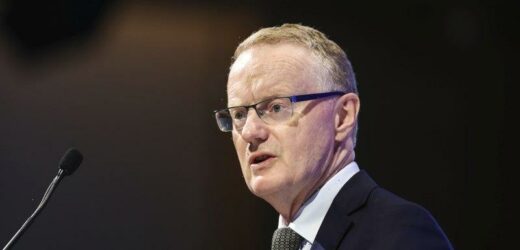Reserve Bank governor Philip Lowe has sought to play down expectations of an interest rate rise in the run-up to this year’s election, saying Australia has time on its side to drive down unemployment without facing major inflation pressures.
Addressing the National Press Club in Sydney on Wednesday, Dr Lowe said he was optimistic about the economic outlook but cautioned against expectations of a sharp lift in wages because that could force the bank into moving faster on interest rates.
RBA governor Philip Lowe has sought to play down expectations the bank will soon lift official interest rates.Credit:Dominic Lorrimer
The bank this week decided to end its quantitative easing program which has pumped hundreds of billions of dollars into the broader economy. It also made no change to the official cash rate which remains at 0.1 per cent.
Inflation, which the bank attempts to hold between 2-3 per cent, is at 3.5 per cent while the unemployment rate is at 4.2 per cent.
This has prompted financial markets to price in an interest rate rise by the middle of the year while many economists expect the bank to move by year’s end. Any rate rise would hit the nation’s mortgage holders who have taken on record levels of cheap debt that in turn has fuelled a surge in house prices.
Dr Lowe said there was still uncertainty about whether the rise in inflation was a one-off increase due to supply chain problems caused by Covid disruptions across the globe or a systemic increase in price pressures.
He said inflation was running higher in many other countries, giving Australia the chance to hold back on an interest rate change.
“We are in the position where we can take some time to obtain greater clarity on these various issues. Countries with higher rates of inflation have less scope here,” he said.
“The board is prepared to be patient as it monitors the evolution of the various factors
affecting inflation in Australia.”
Dr Lowe said Australia was within reach of an historic milestone with the bank forecasting unemployment to fall to 3.75 per cent by year’s end. That would be a 50-year low for the jobless rate.
Prime Minister Scott Morrison said on Tuesday Australia had a “once in a lifetime opportunity” to drive unemployment below 4 per cent in the second half of the year.
He said the bank, whose mandate includes reaching full employment, would take its time to determine how the jobs market was feeding into inflationary pressures.
“As we navigate towards full employment, we have scope to take the time to distil the balance between supply and demand in the economy,” he said.
“Over the course of this year, we will be watching how the various supply-side problems resolve and the effects on prices. We will be watching consumption patterns and whether they normalise. We will also be looking for further evidence that labour costs are growing at a rate consistent with inflation being sustained within the target range. We expect this evidence to emerge over time, but it is unlikely to do so quickly.”
Inflation is currently running far ahead of wages growth. Dr Lowe said the bank is forecasting underlying inflation to be around 2.75 per cent this year and next.
But the governor said suggestions of a surge in wages had yet to materialise, revealing the RBA expects the wage price index to increase by 2.75 per cent this year and 3 per cent in 2023.
“Wages growth has picked up as well, but it has only just returned to the rates prevailing prior to the pandemic,” he said.
“A further pick-up is expected, though there is substantial inertia in aggregate wage outcomes even if there are large wage increases in some pockets. This inertia stems from multi-year enterprise agreements, the review of award wages that takes place on an annual basis and public sector wages policies.”
Dr Lowe said while Australia had done much better than feared out of the Covid pandemic, there were still issues that had to be confronted.
“We also face the challenge of lifting productivity growth, including through investing in the
workforce skills and technologies that are needed to generate sustained increases in real wages,” he said.
“And over time and as conditions allow, we will need to navigate a return to more normal settings of monetary policy.”
Our Breaking News Alert will notify you of significant breaking news when it happens. Get it here.
Most Viewed in Politics
From our partners
Source: Read Full Article



